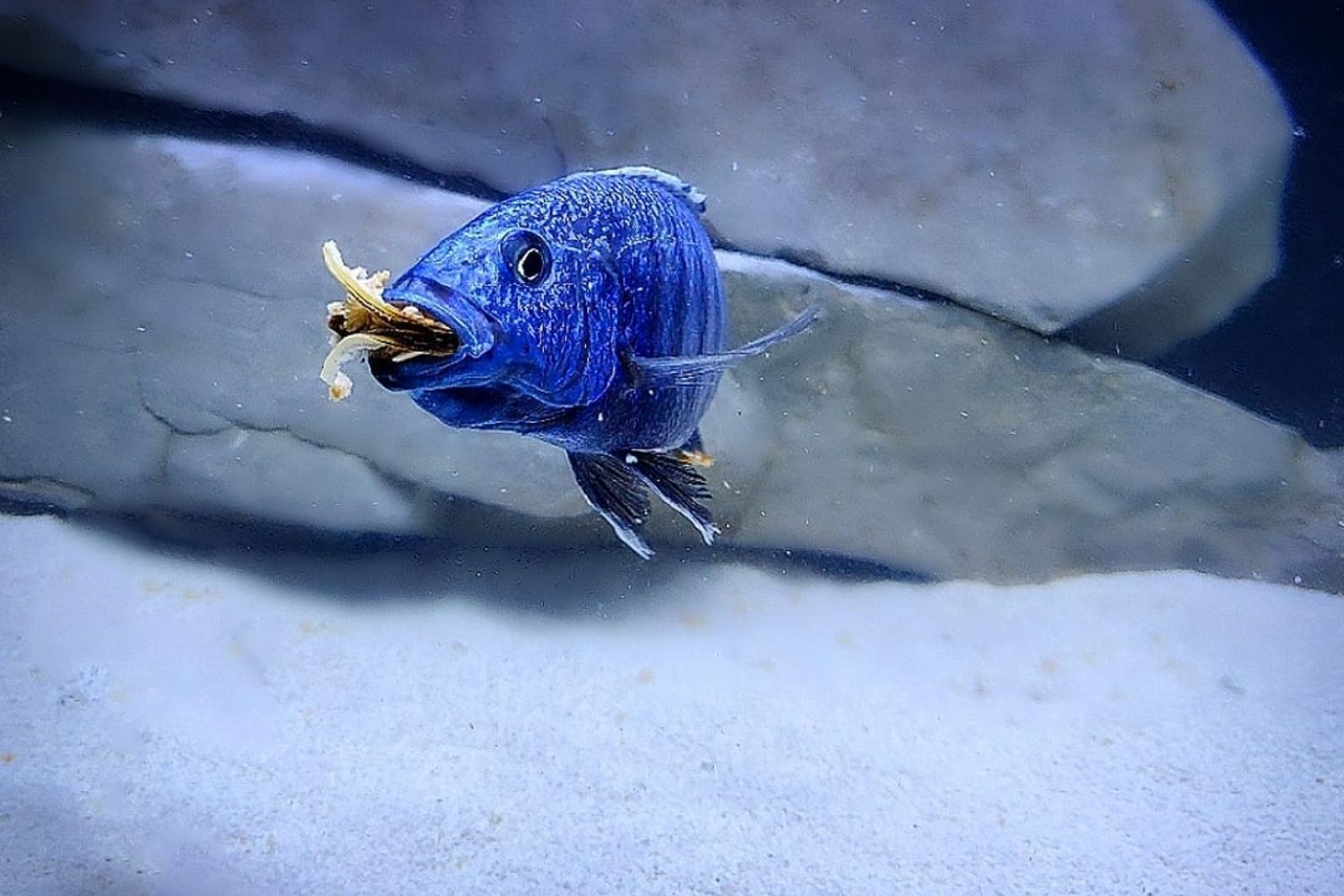Talking about the best fish food or best cichlid food makes you understand how complicated fish are and especially their eating habits. Specifically fish like Cichlids are just as diverse as they are mesmerizing with their vibrant colors. From habitat to dietary needs, fish aren’t just little species that live in a glass box. They come in such variety it might be overwhelming to even distinguish them from each other, let alone take care of them properly.
Cichlids have specific dietary needs where food quality, frequency, and balance play a great role not only in their basic needs for surviving but also in their health and coloring. This article will explain the do’s and don’t-s about feeding these remarkable fish and how you can better ensure them of a complete and regulated diet.
- Best Overall: Omega One Super Color Cichlid Pellets Sinking
- Best for Small Cichlids: New Life Spectrum Cichlid Fish Formula
- Best Herbivore Cichlid Food: Repashy Super Gree
- Best for Enhancing Color: Northfin Food Cichlid
- Best for Vegetarian Cichlids: Omega One Veggie Rounds
- Best Nutrients: Fluval Bug Bites Cichlid Fish Food
- Best Freeze-Dried Food: Tetra Cichlid Food Bloodworms
- Best for Feeding Fry: Hikari Cichlid Food Staple
- Best Pellets: Aqueon Cichlid Pellets
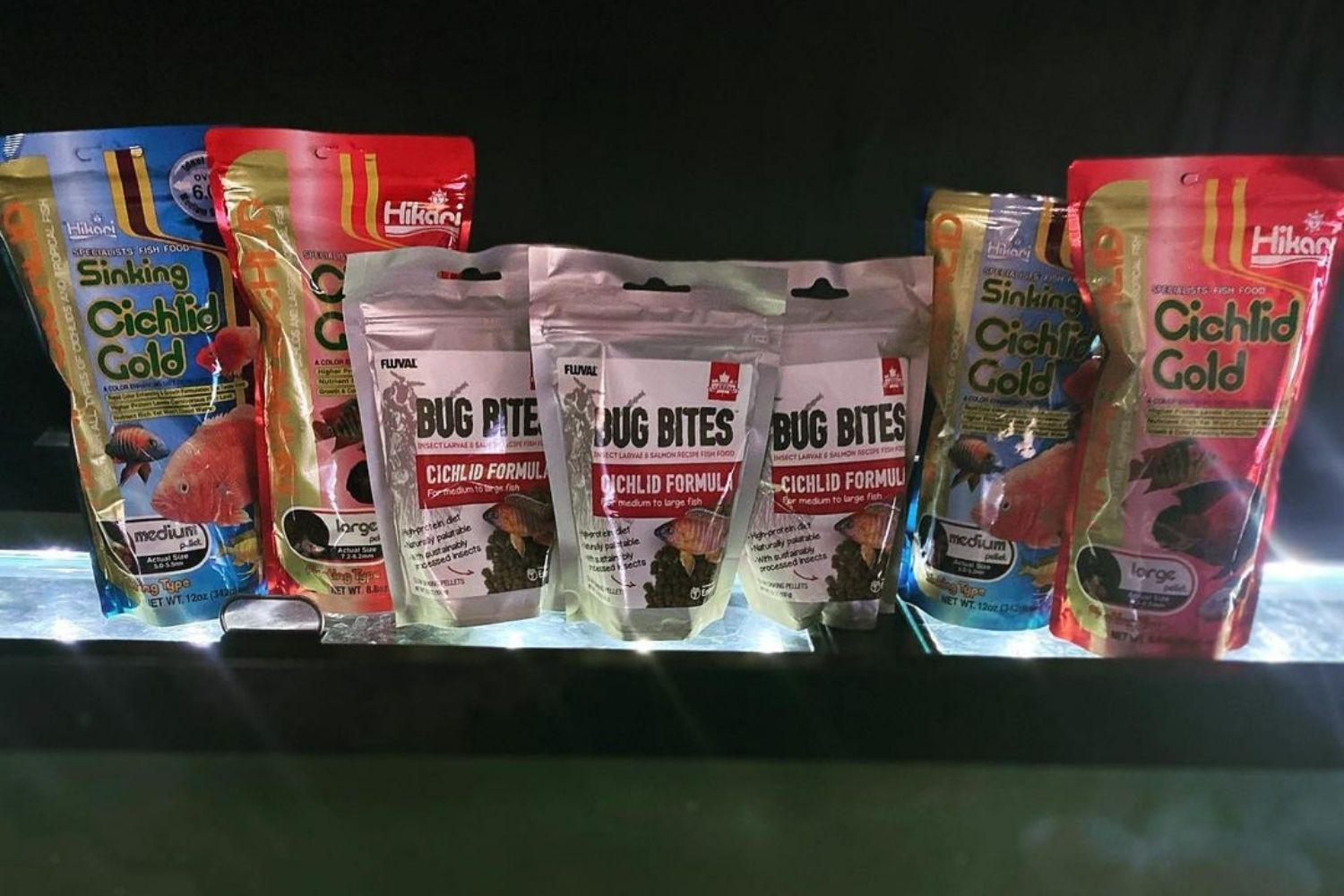
You must know your Cichlid diet before purchasing the best Cichlid food.
Best Cichlid Food Reviewed
In this selection of products, we’ve considered, studied, and handpicked the best fish food for your Cichlid out of thousands of others on the market. We’ve awarded a title for each of them, but they’re all equally good in different ways.
Below you’ll find a review and quick facts for all of them regarding nutrition, diet type, and more.
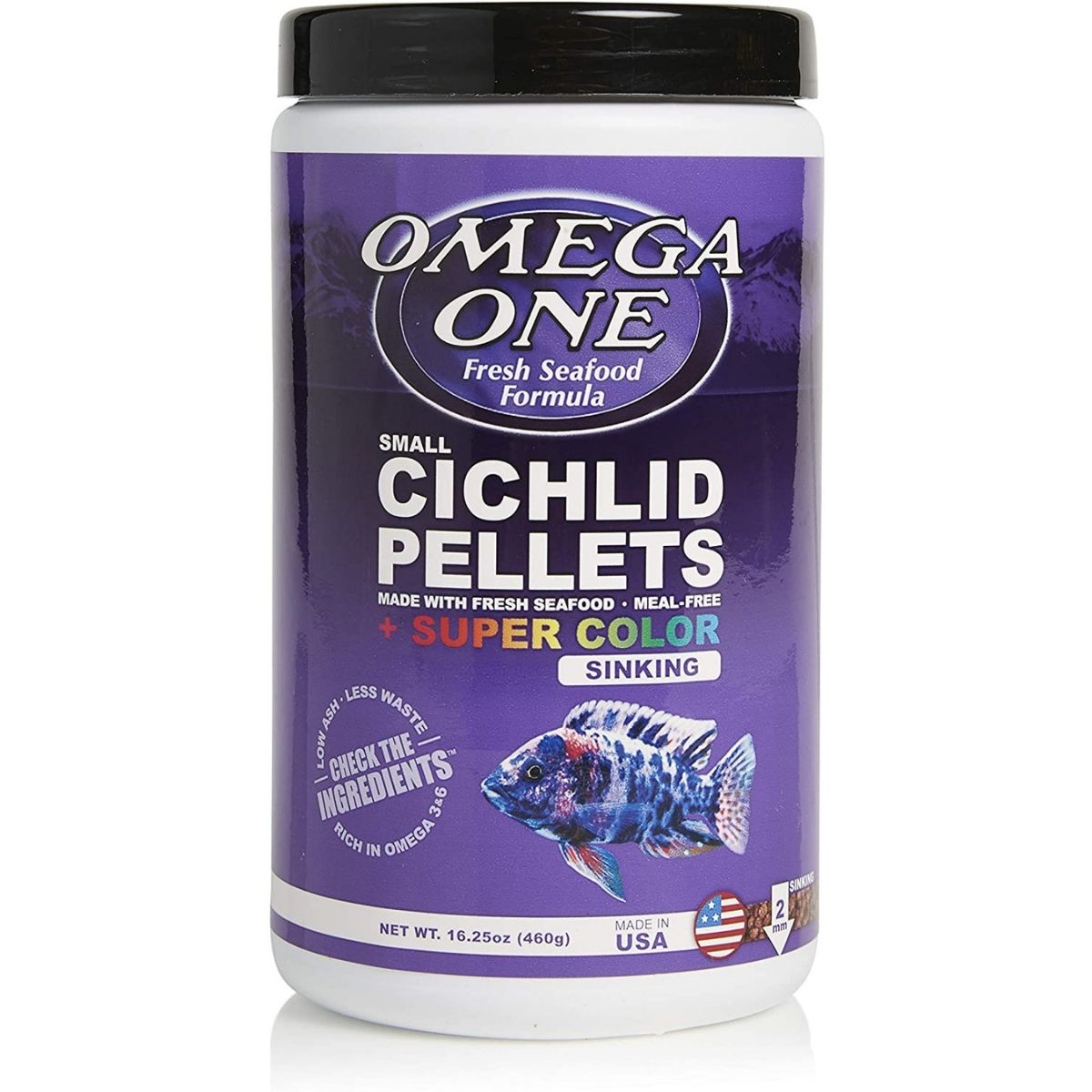
We have kept and rise different types of cichlid. Along the road, we have purchased and tested a lot of different types of foods for them. Omega One is our best recommendation for everyone out of thousands of products on the market.
As said by the company itself, it’s made of mainly healthy wild-caught fish food. It’s an all-rounder, rich in color-enhancing nutrients, decreases water pollution in your tank, helps in your Cichlid’s immune system, and also has very few fillers which make it perfect for everyday fish food. Most fish love it and it comes in sizes applicable to your fish.
Product Specs
- Diet type: Carnivorous, Omnivorous
- Food type: Sinking Cichlid Pellets
- Protein: min 42%
- Fat: min 11%
- Fiber: min 2%
- Best quality: Color enhancing

One of the most affordable choices here, the New Life Spectrum formula is high in protein, color enhancers, trace minerals and it’s good for your Cichlids immune system. It’s perfect for small fish considering the pellets are a little small.
It’s well balanced on nutrients and it’s easily the runner-up to the overall best. We have used this product for Electric Blue Ram Cichlid and they seem to love it and grow healthier.
Product Specs
- Diet type: Omnivorous
- Food type: Sinking Cichlid pellets
- Protein: 37%
- Fat: min 8%
- Fiber: max 7%
- Best quality: Good ingredients, small and easy to digest
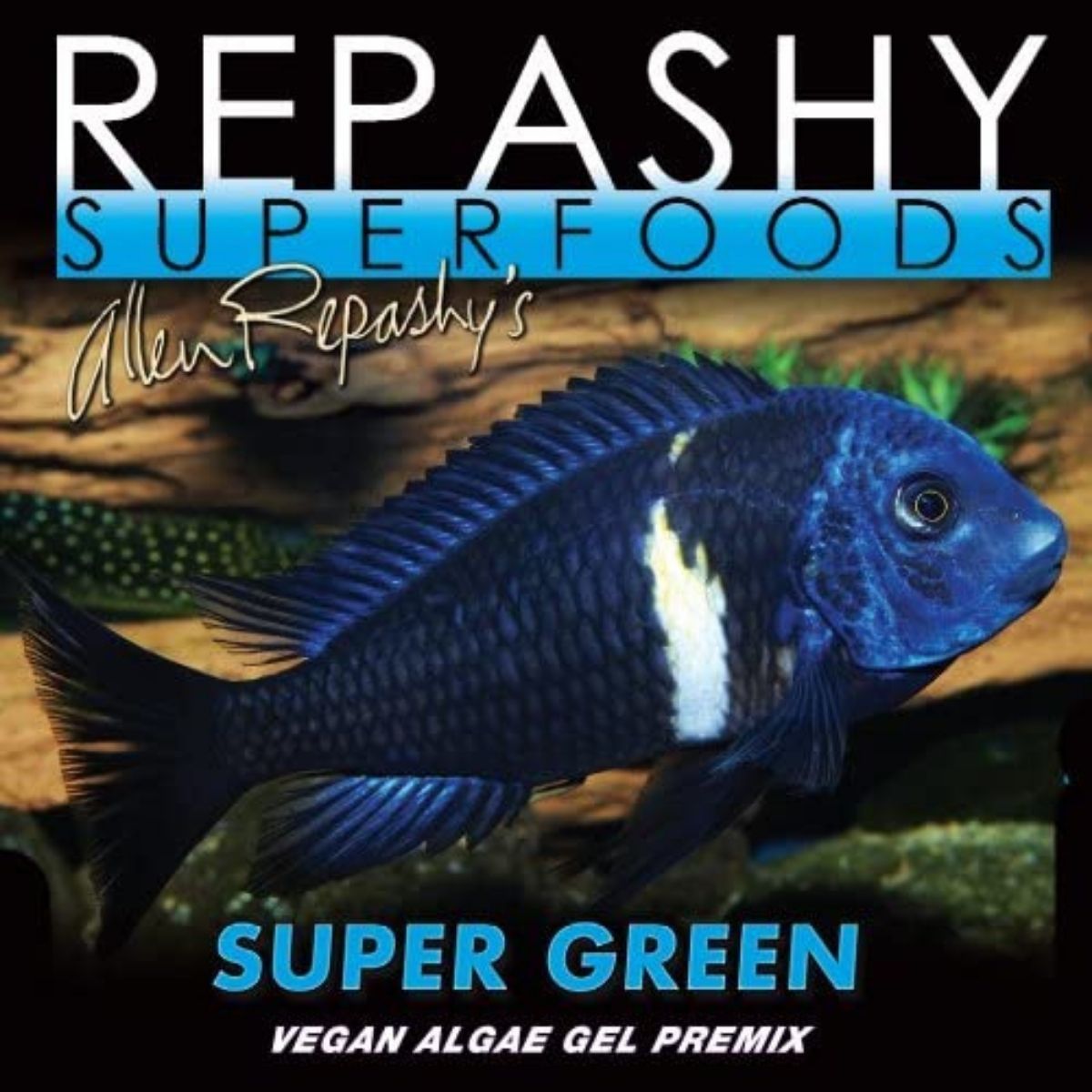
Repashy Super Gree is the only truly vegetarian option for your Cichlids. Full of high-nutrient ingredients and with that gel consistency that avoids fillers altogether, it’s easily the best food you can get for your Herbivores. It’s also a good option for omnivores since it contains ingredients that can keep the balance with their general diet. It’s a safe option, and one of the best in the market.
Product Specs
- Diet type: Herbivorous
- Food Type: Gel
- Protein: min 40%
- Fat: max 8%
- Fiber: max 8%
- Best quality: Fully Vegetarian, no fillers
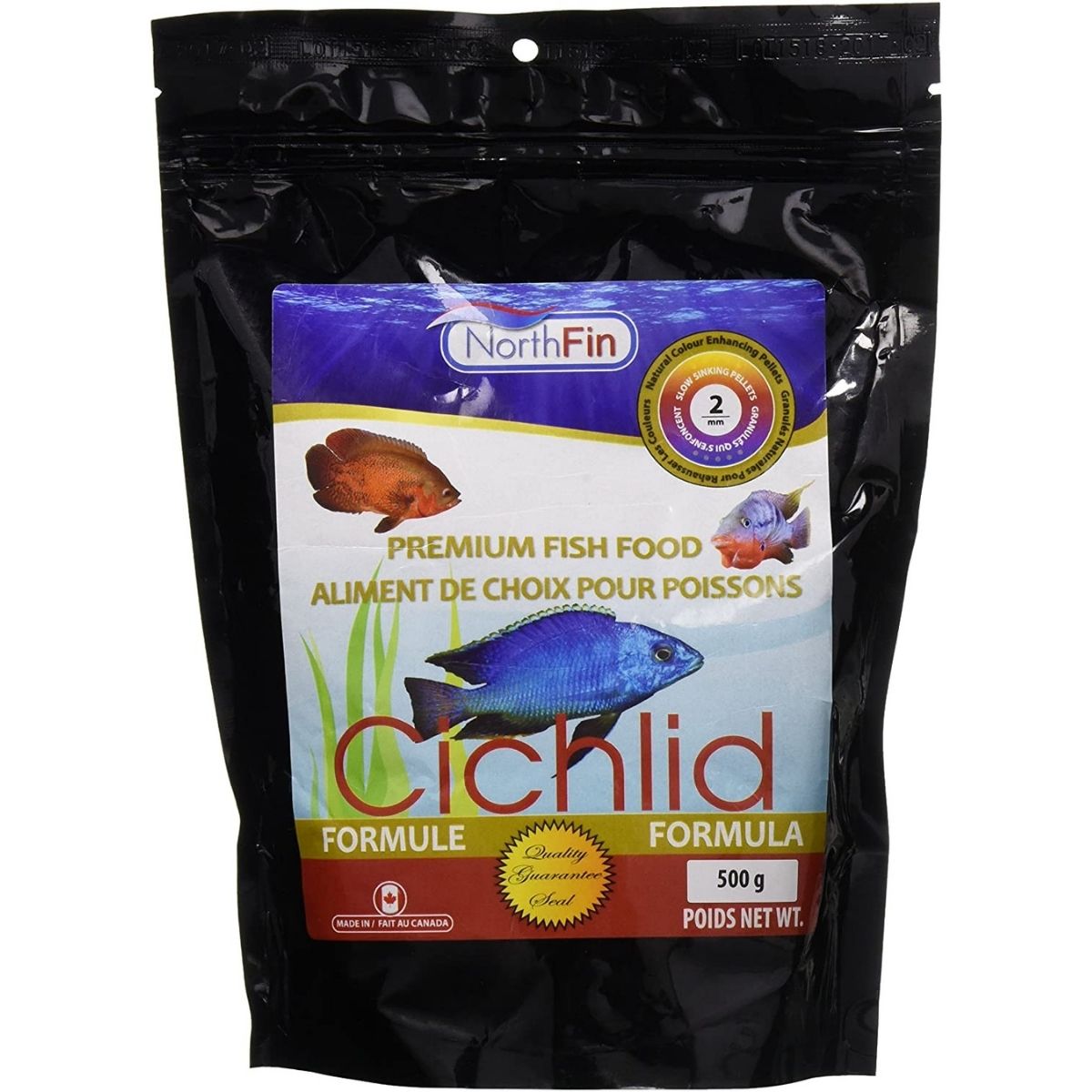
This formula, made with Antarctic krill is an amazing option for a natural color boost. In fact, it’s specially formulated to do exactly that! No fillers or artificial color preservatives make it completely healthy for your fish and a great option, especially for carnivorous Cichlids.
Just to test this product out, we purchased it and fed one of the most colorful cichlids, Peacock Cichlid. The result was expected, truly amazing color.
Product Specs
- Diet type: Carnivorous, Omnivorous
- Food type: Pellets
- Protein: 40%
- Fat: 5%
- Fiber: 5%
- Best quality: Boosts color
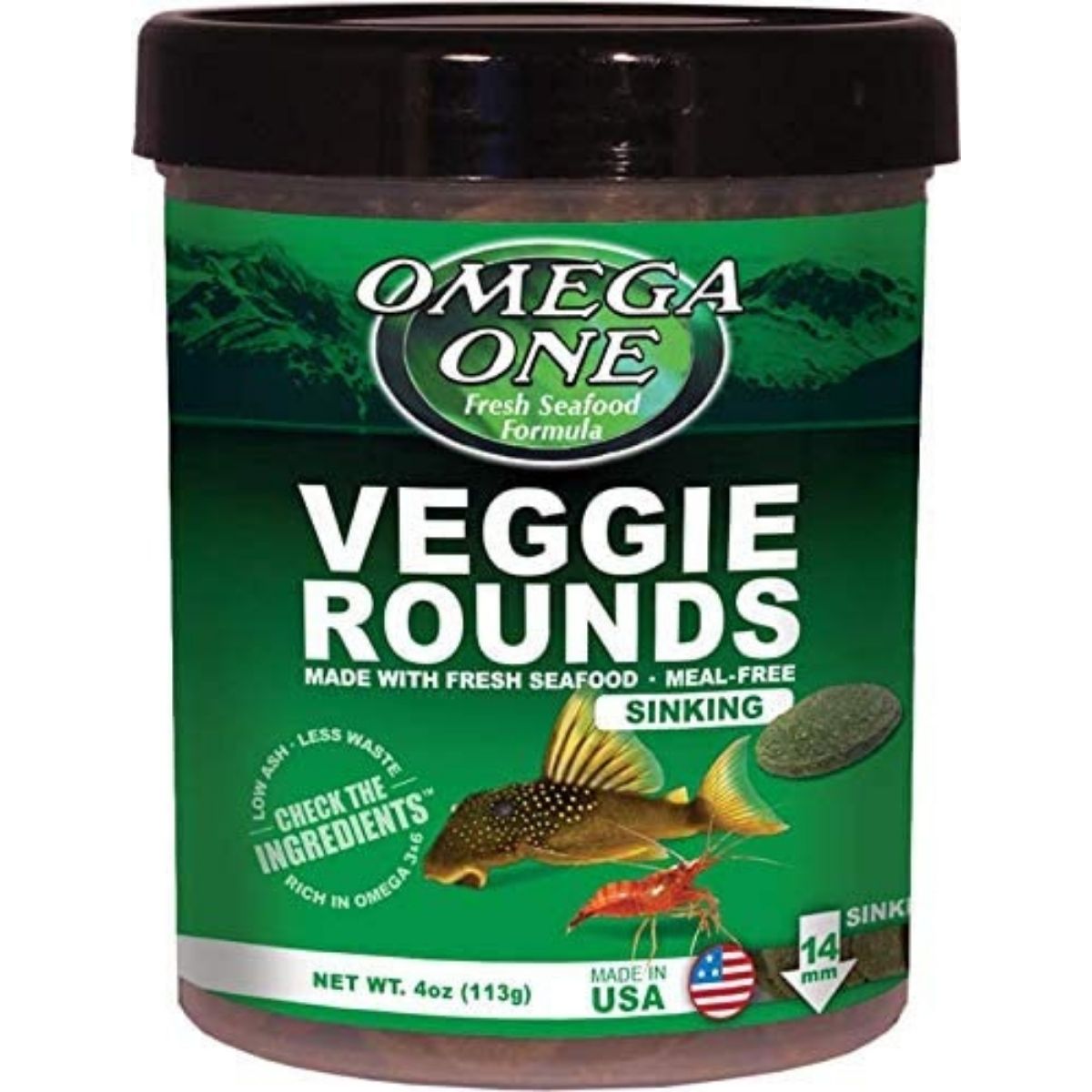
As you probably can tell from the title we were between this and Repashy for best herbivore Cichlid food. However, after further consideration, Omega pellets contain several things to boost your Cichlids immune system. It contains ingredients like Spirulina which helps to destroy internal pathogens and bacteria,
Omega 3 and 6 that boost the immune system and growth, and has low levels of starch which is not good for herbivorous fish. It’s easily the best choice to focus on health and growth for your Cichlids.
Product Specs
- Diet type: Herbivorous, Omnivorous
- Food type: Sinking pellets
- Protein: min. 35%
- Fat: min 10%
- Fiber: max 4%
- Best quality: Helps immune system
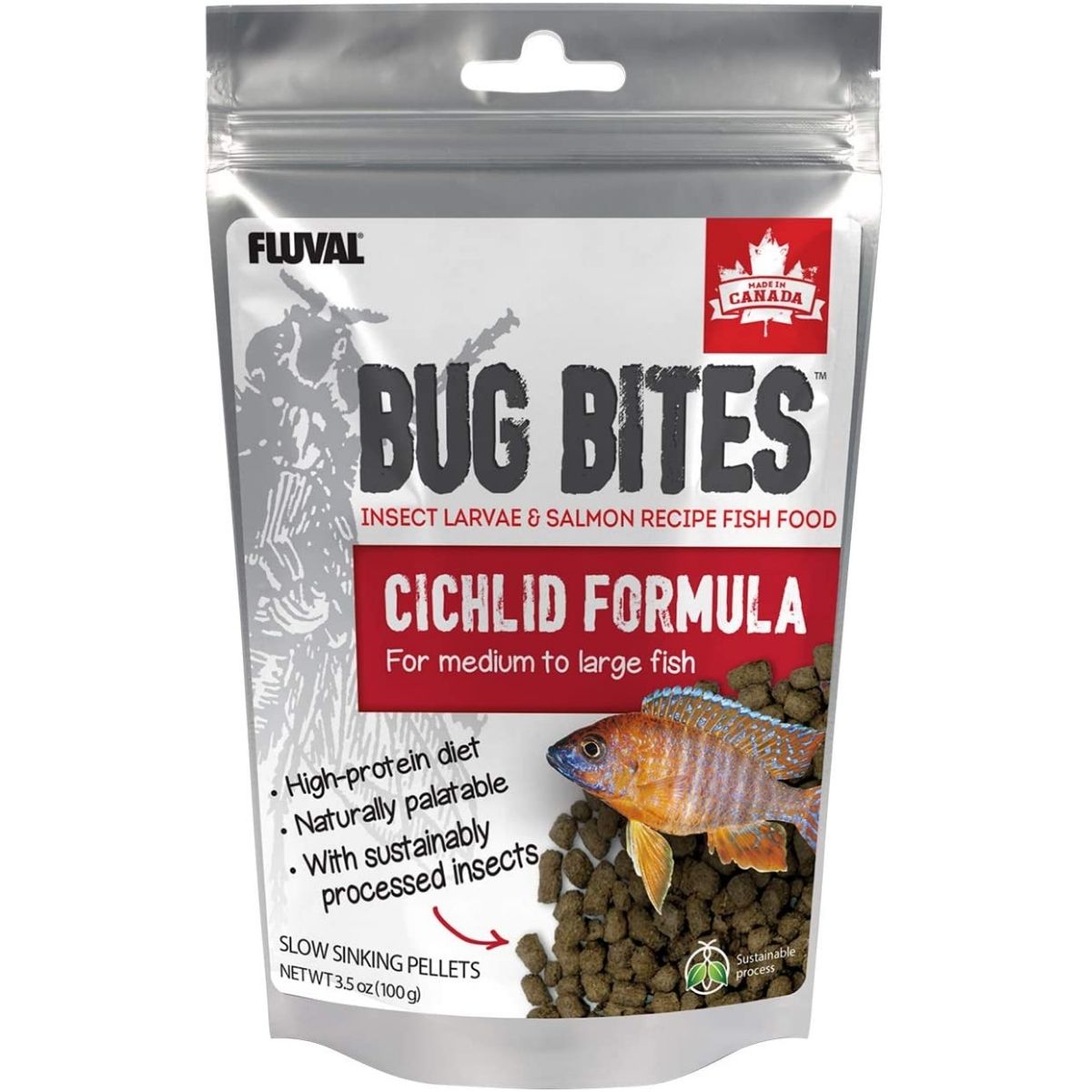
Definitely the best pick for a protein-filled diet, the Fluval Bug Bites is full of vitamins, minerals, amino acids, proteins, and well, bugs. 40% to be exact. It’s free of fillers, preservatives, and colors which makes it completely safe and trustable.
It’s mainly suitable for carnivores and bigger fish and it’s a favorite among aquarists. We use this product for most of our carnivorous cichlid, especially for Wolf Cichlid.
Product Specs
- Diet type: Carnivorous
- Food Type: Granules
- Protein: min. 40%
- Fat: min. 12.5%
- Fiber: max. 5%
- Best quality: Filled with nutrients
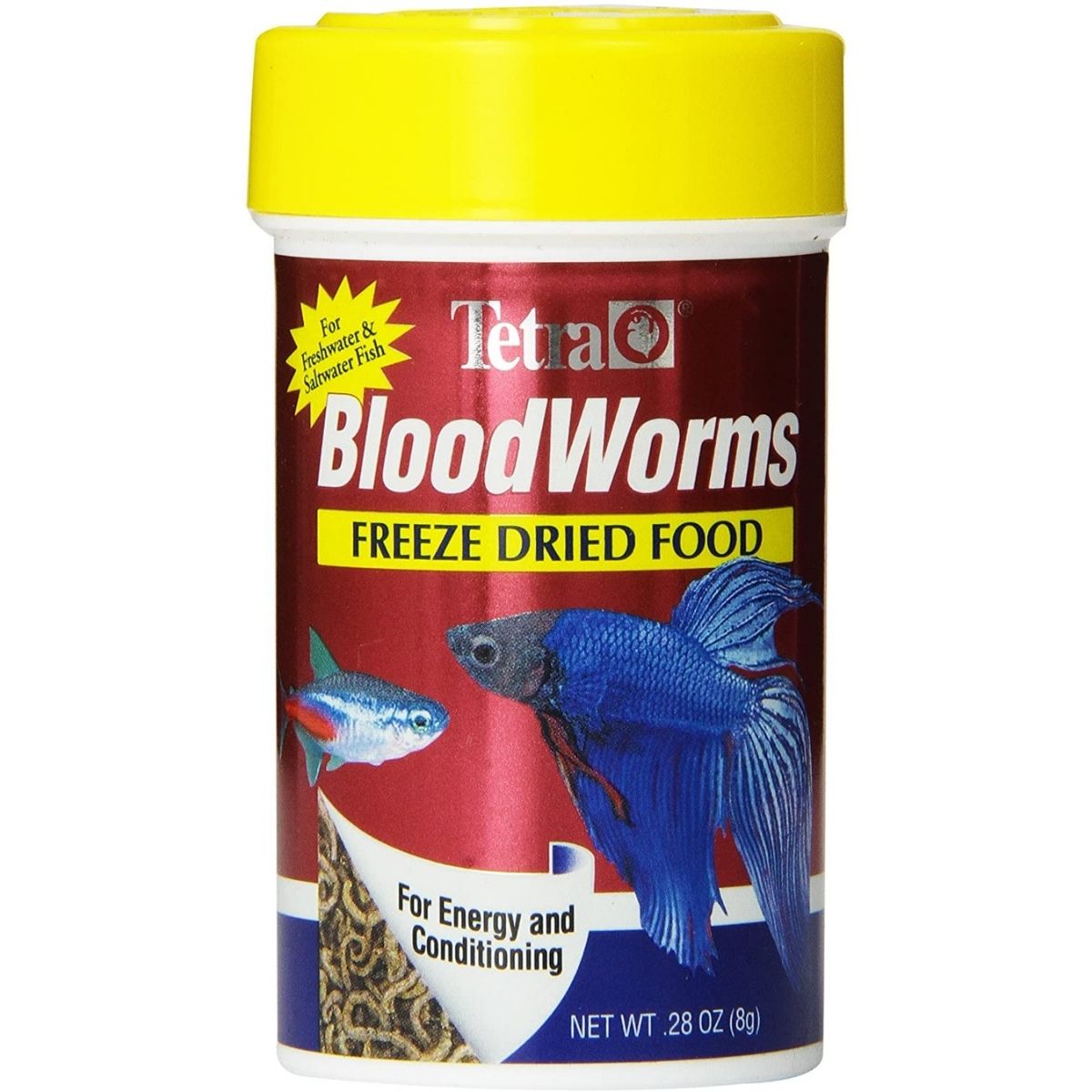
Tetra Bloodworms it’s a perfect freeze-dried treat that provides the perfect nutrition, balanced diet, and that extra energy for your fish. Considering it’s made up of mostly actual bloodworms, there are little to no fillers in them. Naturally tasty to your Cichlids as well, this will be an easy choice for occasional treats and probably one of your fish’s favorites.

They don’t cloud the water, they support the immune system and they’re high on vitamin C and proteins. A solid choice for everyday fish food, and an affordable one as well. Hikari Cichlid food is a great choice for feeding fry.
We think this product must be in your basket because you can use it for other fish than cichlid, such may be Bettas or Apistogramma These are floating pellets that also help with color fading.

Balanced nutrition, premium ingredients, and appealing to your Cichlids, they might be a nice addition to your fish’s diet. It’s affordable to not break the bank and provides for good everyday food as well. Aqueon offers large Cichlid food and small Cichlid food for all varieties so the size of the packages and the pellets themselves won’t be a hassle.
These Cichlid food pellets are suitable for omnivores and they’re slow sinking pellets which means enough time for all your fish to get a bite.
Diet Necessities for Your Cichlid
As mentioned earlier, Cichlids come in great diversity. They have just as many varieties for their diet as they have colors. These not-at-all-capricious fish feed on meat, plants, and basically anything available in their natural habitats or fish pellets, flakes, sticks, and veggies when they’re happily swimming in an aquarium.
They can go 7 or 10 days without food so you can go on your week-long trip and find them in perfect health, granted that you took good care of them before. Using an automatic fish feeder while you are on a trip is a life-saving solution for your fish. You only have to feed them 2 or 3 times a day, as much as they can eat in 2 minutes. Furthermore, we’ll go through all you need to know about the eating habits of these marvelous fish.
What Do Cichlids Eat?
Well, that depends. For Cichlids (and fish in general) it is important to prioritize the nutrients over anything else. Feeding African Cichlids ( or any kind for that matter) isn’t an easy job. It’s not like you can hop on to your local store to find their native African cichlid food subjects and bring them home.
So what can you feed them exactly? We’ll soon go into detail about their diet but the main thing to keep in mind is to have a mix of fresh foods as well as store-bought.
Cichlids can eat a wide variety of things from household veggies to marketed foods. However, you need to be sure that they aren’t filled with…well; fillers! Primarily grains and starches that cause health problems and don’t provide any value in nutrition.
What Do Cichlids Eat in the Wild?
In the wild, they eat a variety of different foods depending on their ecosystem and dietary groups. Most Cichlid species are omnivores and eat whatever is available whether it be plant or meat. Depending on the different species and their habitats, they group into:
- Carnivores like Jaguar Cichlids, Frontosa Cichlids, Wolf Cichlids, etc., eat other small fish, invertebrates, crustaceans, planktons, bloodworms, and insects. Their digestive tract breaks down fat and protein rather than fiber, but this doesn’t stop them from having some vegetable matter in their diet.
- Omnivores Rusty Cichlids, Peacock Cichlid, Firemouth Cichlids, etc., on the other hand, feed on both animals and plants. They make up most of the Cichlids. To them, everything is prey, obviously besides their predators. Unlike their carnivore cousins, they can digest most foods comfortably.
- Herbivores like Pearlspot Cichlid, Tropheus, Mbuna, etc., maintain a diet of algae, biofilm, and plants. Their digestive tracts are optimized for absorbing nutrients from foods but not for breaking down protein, which causes them bloating.
Feeding Cichlids at Home
We’ve talked a great deal about the diet of these fishes in the wild. But how can you fulfill all their needs in nutrients and more at home? There are two ways you can go about this, although the healthiest fish include a combined diet of both store-bought and kitchen food.
Whichever way you choose to feed your Cichlids it’s important to stay away from fillers.
Fillers are starches and grains like potato, rice, corn, soy, wheat, bread, oats, etc., They’re used as a cheap alternative to humans’ and pets’ food sources to add more calories and feel “fuller” without the need for proper nutrition.
However, just like fast food for us, they’re still just junk food overall. It causes fish to bloat and constipation resulting in small problems short-term and even bigger problems long-term.
Store-Bought Fish Food: What to Choose?
Below you’ll find that the store-bought foods are probably just a matter of choice and style and rarely have to do with any difference in ingredients. Make sure you’ve grabbed the right one for the fish you have and you’ll be good to go.
- Flakes are easily the most popular choice when it comes to fish food. They’re pieces of fish food crushed into a paper-thin layer. They dissolve mid-water which makes them perfect for the fish that swim in the middle of the tank and bad news for bottom-feeders.
- Fish Pellets are a mixture of ingredients turned into small capsules suited to the needs of each fish, rather it is in diet or where they like to eat. They can be floating pellets or slow sinking pellets. The latter falls slowly in the aquarium so even the mid-feeding fish can get a bite. The floating pellets contain air (hence the floating) and make them perfect for top feeders. However, some of them cause bloating to certain fish, which is definitely not the case with the Fluval Bug Bites Cichlid Fish Food which we consider as Top-Nutrient pick of Cichlid pellets!
- Tablets – If you’d like to watch your beautiful Cichlid eating, you’d appreciate tablets a lot. They stick to your aquarium walls and you can grab your popcorn and witness their tails wiggling to get the first and best bite. It’s great to show off to your guests all the shy fish like Rusty Cichlid or Electric Blue Ram Cichlid that hide behind the decorations of the tank.
- Crisps – are if flakes “added some weight”. The added thickness might seem irrelevant but that means they stay longer afloat and dissolve slower. The reason why they’re not a proper replacement is that they’re generally more expensive and sometimes a little too big for smaller fish mouths.
Fresh & Live Fish Food
When it comes to fresh products, you have to be more careful. You don’t usually have an ingredients list in the back of spinach leaves, nor do you have reviews to make sure you’re making the right choice. Luckily for you, you’ve got us.
Below you’ll find foods that you can feed your cichlids. The best thing to do would be to see them more as a treat rather than the main foundation of meals. Whatever you feed your precious Cichlid, make sure to cut them finely or blend them and freeze them to ice cubes.
- Frozen food including worms, shrimp, crabs, lobsters, larvae, etc. Frozen Cichlid food is perfectly healthy as long as you do it right. Make sure not to re-freeze the food and thaw before use so your Cichlids won’t come across bacteria.
- Live Food is probably going to be the hardest to find and the most expensive. It’s to the point that most people cultivate live fish foods themselves such as worms, bloodworms, larvae, etc., or easier subjects to raise such as brine shrimp.
- Vegetables like broccoli, spinach, zucchini, squash, cucumbers, or peas would be a great snack for Cichlids and better be used every so often as treats.

Use pigment boosters fish food to enhance your cichlid color.
What to Consider when Buying Cichlid Food
Besides making sure that you know what food to feed them, you should also know how a certain food impacts a specific fish breed. The best food for Peacock Cichlids won’t be the same with the best Electric Blue Ram Cichlid food. Here’s a list of the main things to consider.
Dietary Types
If you own Carnivore species like the neon-spotted Jack Dempsey you obviously can’t feed them with just plants and algae. They need meat in their food otherwise your carnivorous Cichlid will be the furthest thing from healthy.
As for the herbivores, you’ll probably scare the poor things if you try feeding them insects or larvae every day. If you give them protein-rich foods you actually might cause bloating, and that would be the least of your problems.
Omnivores would seem easy to feed considering that in the wild they eat it as long as it’s not eating them. However, they need a balance of both meat and plant in their diet so they can thrive in both health and happiness. The way to love starts from the stomach, and you can be sure your fish will feel just that if you know to feed them well.
Pigment Boosters: Enhance Cichlid Color
Steroids for fish? Nope. Pigment boosters are simply products with carotenoids in them that enhance the color of your fish naturally. It’s a compound found in fruits and vegetables that gives them their pigment. A certain type of carotene gives fruits and vegetables a certain color.
For example, zeaxanthin and lutein carotenoids cause foods like egg yolk, bell peppers (the yellow ones), turmeric, etc., to get a yellow tint. Beta carotin, which is the most popular of all, makes foods like carrots or paprika orange. Whereas astaxanthin is responsible for the red pigment in red bell peppers, shrimp, etc.
These compounds can’t be produced by fish or most animals themselves, so if you’d want to spice your Cichlids’ beautiful color a bit more, you should feed them with foods rich in the carotenoids corresponding to their colors. Rather it is store-bought or kitchen products, it would be a healthy addition besides aesthetic since some carotenoids are also important for your fish’s well-being.
Nutrients Balance
As it’s been said many times already, what you feed your Cichlid mainly depends on what those Cichlids eat in the wild. However, considering their nature and nature in general, food isn’t easy to come by and they can’t exactly be picky about their meals.
In “the real world” you’d see different dietary types messing with each other’s lunch and that’s pretty normal. Kind of -fishy- if you’d ask me.
Puns aside, if they’re used to different nutrition in nature, you need to reproduce that the best way you can. Always make sure the Cichlids foods you choose have the right nutritional balance and don’t be afraid to mix it up a little sometimes.
Fillers: Avoid if Possible
Also mentioned earlier, fillers are basically burgers, fries, and soda but for your fish (minus the deliciousness), which makes them not only useless but a big troublemaker for your fish.
It causes digestive problems, and you can be sure that if you don’t like an upset stomach, your Cichlids won’t like it either.
In our selections of best Cichlid foods, we’ve made sure to include ones that have little to no fillers to give you peace of mind, and your fish a real happy meal. (pun intended)
Fiber
Fiber, although it’s not digestible by fish, is a very important ingredient for some of their diets. It’s almost compulsory to give the right amount of fiber to your fish, especially herbivores.
Too much for your carnivores or too little for your herbivores might get you and your fish into an uncomfortable position. It’s important to keep in mind that fiber doesn’t contain nutrients or vitamins.
Their main purpose is to help certain fish have more time to process food and absorb the things they need and also helps to avert constipation.
How Frequently Should I Feed My Cichlids?
Typically, you would need to feed them little, but often. Small amounts (approx. the size of their eyeballs) that they can eat within a couple of minutes, around 2-3 times a day. This helps to give all the fishes something to eat because they might be hostile toward each other in feeding hours.
Remember that Cichlids are combative for food because, in the wild, they live in crowded areas with limited food resources, so they’ll probably always seem hungry. If that’s not the case, consider feeding them just twice a day.
Don’t forget to remove the remaining food after your fish has been fed, to avoid different problems that might arise. Their biological opportunistic nature might lead them to health problems such as overeating, constipation, or the creation of ammonia from rotten food.
Conclusion
In conclusion, the best thing you can do is take your time to know your fish and their habits. Don’t be afraid to experiment with different brands and foods to see which one your Cichlids prefer.
However, make sure not to only give them what they like rather than what’s best for them. Whether it be dogs, cats, birds, tarantulas, alligators, or Cichlids, as long as we choose them as pets they are our responsibility and we must provide the best possible treatment for them.
Their little tails wagging underwater compensate for all the effort put into these colorful, mesmerizing creatures.
